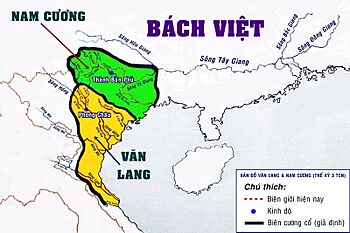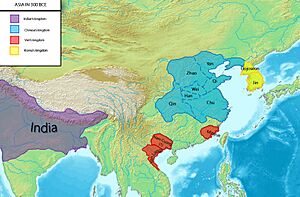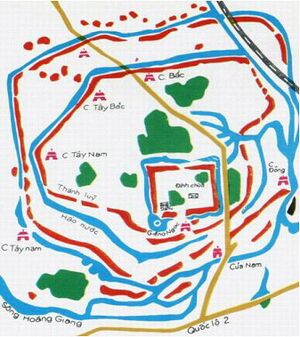Âu Lạc facts for kids
Quick facts for kids
Âu Lạc
甌貉/ 甌駱
|
|||||||||||
|---|---|---|---|---|---|---|---|---|---|---|---|
| 257 BCE–179 BCE | |||||||||||

Nam Cương ruled by Âu Việt people (Green) and Văn Lang ruled by Lạc Việt people (Yellow) on map. In 257 BCE, Nam Cương conquered Văn Lang and formed Âu Lạc
|
|||||||||||
| Capital | Cổ Loa | ||||||||||
| Government | Monarchy | ||||||||||
| King | |||||||||||
|
• 257 BCE – 179 BCE
|
An Dương Vương (first and last) | ||||||||||
| Historical era | Classical antiquity | ||||||||||
|
• Established
|
257 BCE | ||||||||||
|
• Zhao Tuo annexed Âu Lạc
|
179 BCE | ||||||||||
|
|||||||||||
| Today part of | China Vietnam |
||||||||||
Âu Lạc was an ancient kingdom that existed in parts of what is now Guangxi in China and northern Vietnam. It was founded in 257 BCE by a leader named Thục Phán, also known as An Dương Vương. This kingdom was formed by joining two groups of people: the Âu Việt from Nam Cương and the Lạc Việt from Văn Lang.
Âu Lạc's capital city was Cổ Loa, which is located near modern-day Hanoi in Vietnam. The kingdom lasted for about 78 years before it was taken over by the state of Nanyue in 179 BCE. Nanyue itself was later conquered by the powerful Han dynasty.
Contents
History of Âu Lạc
How Âu Lạc Began
Before Chinese rule, the northern and central parts of Vietnam were home to kingdoms called Văn Lang. These kingdoms were led by powerful rulers known as Lạc Kings, or Hùng Kings. They had a structured government with officials serving them.
Around 257 BCE, a strong leader named Thục Phán took control of Văn Lang. Thục Phán was the leader of the Âu Việt people. Some stories say he was a prince or king from the ancient Shu kingdom. The Âu Việt people lived in areas that are now part of southern China and northern Vietnam.
Thục Phán defeated the last Hùng King. He then united the Âu Việt and Lạc Việt people, creating the new kingdom of Âu Lạc. He declared himself King An Dương, or An Dương Vương. Historians say that King An Dương is the first leader in Vietnamese history for whom we have reliable records, though many stories about him are still legends.
Building Cổ Loa Citadel
Cổ Loa was a huge ancient city, possibly the largest of its kind in Southeast Asia. It was the first important political center for Vietnamese civilization before Chinese influence became strong. The city covered a large area, about 600 hectares, and building it required a massive amount of earth and effort.
Construction of Cổ Loa might have started as early as 400 BCE. The main building phase was between 300 and 100 BCE. The enormous size of Cổ Loa's walls and ditches shows that the kingdom was very organized. It had enough resources and people to build and maintain such a huge project. This means the government was strong and had a lot of control. Experts believe building it took millions of workdays. The citadel offered protection and showed off the kingdom's power.
After becoming king, An Dương Vương ordered the building of Cổ Loa as his capital. Its name, Cổ Loa, means "old snail" because its walls were shaped like a snail shell.
A famous legend tells about the building of Cổ Loa. Spirits, led by a white chicken, kept undoing the work each night. They wanted revenge for the son of a previous king. King An Dương prayed for help. A giant golden turtle appeared from the water. The turtle protected the king until the citadel was finished. Before leaving, the turtle gave the king one of its claws. It told him to use it as a trigger for a special crossbow, promising he would be unbeatable. A man named Cao Lỗ made this powerful crossbow. It was called the "Saintly Crossbow of the Supernaturally Luminous Golden Claw." Legend says one shot from it could kill 300 enemies.
The Fall of Âu Lạc
In 204 BCE, a kingdom called Nanyue was founded by Zhao Tuo in what is now Guangzhou, China. At first, Âu Lạc and Nanyue might have been allies against the Han dynasty. However, Nanyue's influence over Âu Lạc lessened after Nanyue made peace with the Han. This freed up Zhao Tuo's army to attack Âu Lạc.
The exact details of the war are not fully known. Some old records mention that Zhao Tuo faced difficulties at first but eventually defeated King An Dương. Other important historical books do not mention this war directly. However, the conflict led to a famous legend about the magical crossbow. This myth says that whoever held the crossbow would rule the land, and whoever lost it would be defeated.
When Zhao Tuo's army struggled, he asked for a truce. He sent his son, Zhong Shi, to King An Dương's court. Zhong Shi and Mỵ Châu, King An Dương's daughter, fell in love and got married. In their society, husbands often lived with their wife's family, so Zhong Shi stayed at An Dương's court. Meanwhile, King An Dương treated Cao Lỗ, the crossbow maker, badly, and Cao Lỗ left.
Zhong Shi tricked Mỵ Châu into showing him the magical crossbow. He secretly swapped its trigger, making it useless. Then he returned to his father. Zhao Tuo immediately launched a new attack and defeated King An Dương. The golden turtle then appeared to the king, revealing his daughter's betrayal. The king killed his daughter for her actions before disappearing into the water. Some historians think the "magical crossbow" might have been a new type of army or advanced weapon created by Cao Lỗ.
After the defeat, Zhao Tuo added Âu Lạc to Nanyue. He allowed local chiefs to continue ruling the people but sent two officials to oversee them. These officials were mainly interested in trade. Their power was limited to a few outposts. Local society in Âu Lạc remained largely unchanged.
In 111 BCE, the powerful Han dynasty conquered Nanyue. They then ruled the region for several hundred years. Even under Han rule, local leaders kept much of their power. They received special "seals and ribbons" as symbols of their status. In return, they paid tribute to the Han. The local way of life and ruling class did not change much until the first century CE. It was only later that the Han government began to rule more directly and tried to make the local people more like the Chinese.
Government and Society
Historians believe that Âu Lạc was a highly organized state with strong political systems between 300 and 100 BCE. The huge effort needed to build Cổ Loa shows that the kingdom had a powerful military and a strong central government. The large number of bronze tools found also suggests that tool production was controlled by the state. This indicates different social classes and that the government controlled important resources. Roof tiles were only found at Cổ Loa, showing it was indeed the capital. Villages around Cổ Loa likely paid taxes to the central government.
Chinese records from that time often described the people of Âu Lạc as "barbaric" and needing to be "civilized." They claimed the local people lacked knowledge of farming, metalwork, and politics. They believed any progress was due to Chinese influence. However, the Chinese also knew that Âu Lạc was a stable, organized, and productive society.
Women in Âu Lạc society had a high status. It was a "matrilocal" society, meaning that after marriage, a couple would often live with or near the wife's parents. Daughters would stay in their mother's home, forming large family groups. Some believe it was also a "matrilineal" society, where status was passed down through the mother's family. Women had rights to inherit property. They also practiced "levirate marriage," where a widow could marry a male relative of her late husband, often his brother, to have heirs. This protected the widow's interests and showed the authority of women.
Population
The region of Âu Lạc had a large population even before the Han dynasty arrived. It's estimated that thousands of people lived in Cổ Loa and its surrounding areas. The wider delta region might have had tens or even hundreds of thousands of people. A census from 2 CE supports this, showing nearly a million people in three prefectures of the region. While some people moved from the north, large-scale Chinese immigration did not happen until later.
Chinese officials called the local people Lạc (Lou) and Âu (Ou). The Lạc people are thought to have spoken languages related to modern Vietnamese. Some historians believe the people in the lowlands spoke an early form of Viet-Muong languages. Those in the mountains to the north and west might have spoken a language similar to modern Khmu. Archaeological findings suggest that the Red River Delta region was mainly home to Austroasiatic speakers before the Dongson period. Later, during the Dongson period, there was also a significant number of Tai-speaking people, possibly living alongside the Vietic speakers.
Economy
The economy of Âu Lạc was based on farming, especially growing wet rice. They used animals like oxen for plowing and had metal plows, axes, and other tools. They also built irrigation systems to water their crops. Rice farming with irrigation might have started as early as 2000 BCE. Metal tools were commonly used even before significant contact with the Chinese. There was also fishing and some specialized jobs among the people.
Northern Vietnam was an important center for trade with other regions. It had a wide trade network long before 1000 BCE. This was because of its good location, access to major rivers and the coast, and rich deposits of copper, tin, and lead ores. Historians believe that the economic and trade value of this region, including its access to waterways and exotic goods, was a main reason why the Chinese wanted to conquer it. Controlling this area gave them easy access to other parts of Southeast Asia.
See also
- An Dương Vương
- Âu Việt
- Baiyue
- Cổ Loa Citadel
- Đông Sơn culture
- History of Vietnam
- Hồng Bàng dynasty
- Lạc Việt
- Nam Việt
- Panyu District
- Tây Vu Vương
- Triệu dynasty
- Trọng Thủy
- Zhao Tuo



